
Microsoft PowerPoint is a presentation program, created by Robert Gaskins and Dennis Austin at a software company named Forethought, Inc. It was released on April 20, 1987, initially for Macintosh computers only. Microsoft acquired PowerPoint for about $14 million three months after it appeared. This was Microsoft's first significant acquisition, and Microsoft set up a new business unit for PowerPoint in Silicon Valley where Forethought had been located.
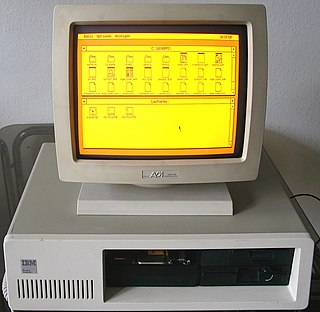
GEM is an operating environment which was created by Digital Research (DRI) since 1984 for use with the DOS operating system on Intel 8088 and Motorola 68000 microprocessors.

Windows Notepad is a simple text editor for Windows; it creates and edits plain text documents. First released in 1983 to commercialize the computer mouse in MS-DOS, Notepad has been part of every version of Windows ever since.

The Am5x86 processor is an x86-compatible CPU announced in November of 1995 by AMD for use in 486-class computer systems. It began shipping in December of 1995, with a base price of $93 per unit in bulk quantities. Before being released, it was in development under the codename "X5".
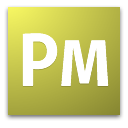
Adobe PageMaker is a discontinued desktop publishing computer program introduced in 1985 by the Aldus Corporation on the Apple Macintosh. The combination of the Macintosh's graphical user interface, PageMaker publishing software, and the Apple LaserWriter laser printer marked the beginning of the desktop publishing revolution. Ported to PCs running Windows 1.0 in 1987, PageMaker helped to popularize both the Macintosh platform and the Windows environment.

Deluxe Paint, often referred to as DPaint, is a bitmap graphics editor series created by Dan Silva for Electronic Arts. The original Deluxe Paint was written for the Commodore Amiga 1000 and released in November 1985. It was eventually ported to other platforms, including an MS-DOS version which became the standard for pixel graphics in video games in the 1990s, the only competitor being Autodesk Animator Pro.
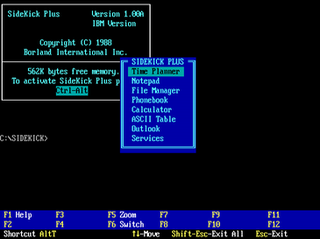
Borland Sidekick was a personal information manager (PIM) launched by American software company Borland in 1984 under Philippe Kahn's leadership. It was an early and popular terminate and stay resident program (TSR) for MS-DOS which enabled computer users to activate the program using a hot key combination while working in other programs. Although a text-mode program, Sidekick's window-based interface echoed that of the Apple Macintosh and anticipated the eventual look of Microsoft Windows 2.0. It included a personal calendar, text editor, calculator, ASCII chart, address book, and phone dialer. According to the prospectus for Borland's initial public offering of stock to the public, Sidekick sold more than 1 million copies in its first three years.

Spinnaker Software was a software company founded in 1982 known primarily for its line of non-curriculum based educational software, which was a major seller during the 1980s. It was founded by chairman Bill Bowman and president C. David Seuss.
Aldus PhotoStyler was a graphics software program developed by the Taiwanese company Ulead. Released in June 1991 as the first 24 bit image editor for Windows, it was bought the same year by the Aldus Prepress group. Its main competition was Adobe Photoshop. Version 2.0 introduced a new user interface and improved color calibration. PhotoStyler SE - lacking some features of the version 2.0 - was bundled with scanners like HP ScanJet. The product disappeared from the Adobe product line after Adobe acquired Aldus in 1994.
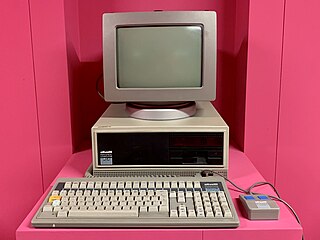
The Olivetti M24 is a computer that was sold by Olivetti in 1983 using the Intel 8086 CPU.
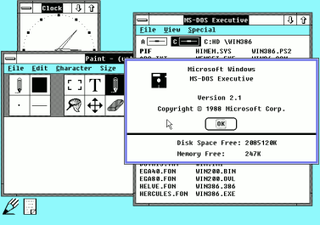
Windows 2.1 is a major release of Microsoft Windows. It was released to manufacturing on May 27, 1988, as a successor to Windows 2.0.

Windows 3.1 is a major release of Microsoft Windows. It was released to manufacturing on April 6, 1992, as a successor to Windows 3.0.
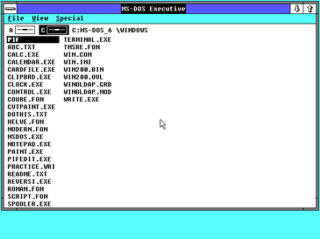
Windows 2.0 is a major release of Microsoft Windows, a family of graphical operating systems for personal computers developed by Microsoft. It was released to manufacturing on December 9, 1987, as a successor to Windows 1.0.

Altos Computer Systems was founded in 1977 by David G. Jackson and Roger William Vass Sr. It focused on small multi-user computers, starting with multi-user derivatives of CP/M, and later including Unix and Xenix-based machines. In its 1982 initial public offering on NASDAQ, the company raised $59M. Thereafter the company's stock was traded under the symbol ALTO.
This outline is an overview of software and a topical guide in list form.
Emissary was a popular early commercial internet suite from Attachmate for Windows. It featured a web browser, FTP support, e-mail program, a newsreader program, and an HTML editor.
InSoft Inc. was an American developer of network-based communications software and multimedia software founded in 1992 in Mechanicsburg, Pennsylvania. The company’s applications included Communique, which is used for desktop collaboration and videoconferencing.
Boeing Calc was a spreadsheet package written by Boeing Computer Services, an independent subsidiary of aviation manufacturer Boeing. It had originally been developed as an in-house accounting tool, but was launched as a commercial product in April 1985 for IBM 4300 mainframes running IBM MVS and IBM PC microcomputers running DOS. The original launch price was $399 per copy for the PC version and $8,899 for a combined PC/mainframe bundle.
PerfectDisk is a defragmentation software product for Windows developed by Raxco.

The Olivetti M20 is a Zilog Z8000 based computer designed and released by Olivetti in 1982. Although it offered good performance, it suffered from a lack of software due to its use of the Z8000 processor and custom operating system, PCOS. The company introduced the IBM PC compatible Olivetti M24 in 1983 and the M20 line was phased out.













